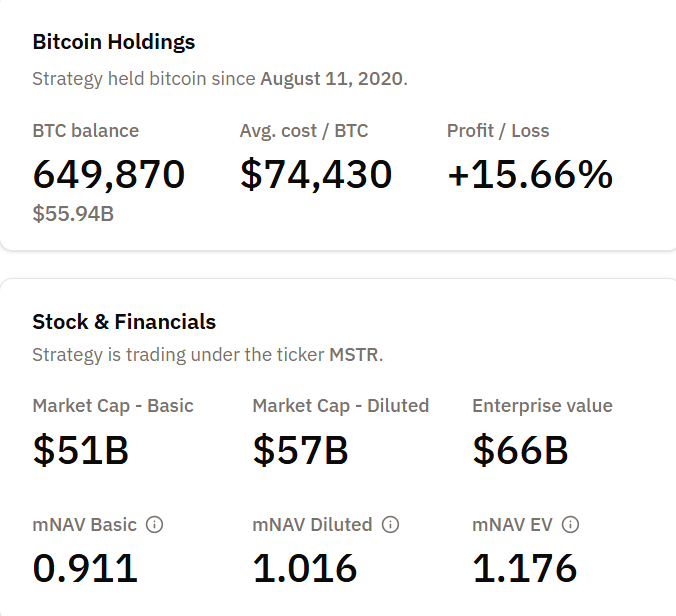MicroStrategy Faces $9 Billion Outflow Risk as Index Providers Eye Bitcoin Holdings
MicroStrategy confronts a critical test as leading index providers consider rules that could strip the company of nearly $9 billion in passive investment flows. MSCI is consulting on new criteria that would exclude firms with digital asset holdings exceeding 50% of total assets. Index Exclusion Threatens Core Strategy MicroStrategy, recently renamed Strategy Inc., holds 649,870
MicroStrategy confronts a critical test as leading index providers consider rules that could strip the company of nearly $9 billion in passive investment flows.
MSCI is consulting on new criteria that would exclude firms with digital asset holdings exceeding 50% of total assets.
Index Exclusion Threatens Core Strategy
MicroStrategy, recently renamed Strategy Inc., holds 649,870 Bitcoin as of this writing, with an average cost of $74,430 per coin. The company’s break-even price matches this purchase point, leaving little margin as Bitcoin trades under pressure.
 MicroStrategy BTC Holdings. Source:
Bitcoin Treasuries
MicroStrategy BTC Holdings. Source:
Bitcoin Treasuries
Its market capitalization is $51 billion on a basic share count and $57 billion fully diluted, while enterprise value is $66 billion.
MSCI began a formal consultation in September 2025 on how to treat digital-asset treasury companies (DATs).
According to MSCI’s official consultation documents, the proposed rule would exclude firms where digital assets comprise 50% or more of total assets and represent the main business activity.
Some clients argue that these companies resemble investment funds rather than eligible operating companies for equity indexes.
The risks extend further than MSCI. Strategy’s stock, MSTR, is listed in several key benchmarks, including the Nasdaq 100, CRSP US Total Market Index, and various Russell indexes.
Analysis from JPMorgan suggests that MSCI exclusion alone could result in $2.8 billion in passive fund sales. If other providers make similar changes, the total outflows could reach $8.8 billion.
The potential removal from benchmarks such as the MSCI USA and Nasdaq 100 presents the biggest challenge yet to Michael Saylor’s Bitcoin accumulation approach. A final decision is expected by January 15, 2026.
Valuation Premium Collapses Amid Bitcoin Downturn
Timing makes these issues more serious. Strategy’s shares have fallen 60% from recent highs, eroding the valuation premium that fueled its capital raise-and-buy strategy.
Its multiple to net asset value (mNAV) has compressed toward parity, reflecting reduced investor confidence in Saylor’s “sell stock, buy Bitcoin, repeat” flywheel.
This premium is crucial because Strategy’s model depends on it. The company issues equity and convertible debt to fund Bitcoin purchases, hoping shares will trade above the value of its Bitcoin holdings.
If that premium is lost, the business case weakens since investors can simply buy Bitcoin directly.
Meanwhile, funding costs have increased. Strategy issued convertible notes earlier in 2025 at higher terms. With Bitcoin underperforming, the firm faces squeezed profitability.
Its Bitcoin holdings show a 15.81% profit as of mid-November, but that margin shrinks if prices fall near the $74,430 break-even.
Market Divided on Index Classification
Not all market participants agree with the proposed exclusion. Matthew Sigel, VanEck’s head of digital assets research, pointed out on X that JPMorgan’s report reflects client feedback shaping index rules, rather than an explicit call for exclusion.
This highlights the issue as being about process, rather than just fundamental company characteristics.
The consultation exposes uncertainty around how finance should classify Bitcoin treasury companies. MSCI’s rules typically separate operating firms from investment vehicles.
Strategy runs analytics software, but gains most attention from its Bitcoin holdings, creating a hybrid identity that complicates classification.
Other companies also face review. MARA Holdings, Metaplanet Inc., and Bitcoin Standard Treasury Company all hold sizable digital assets.
Yet, Strategy’s scale and prominence make it a test case. If removed, it will set a precedent for how indexes treat public firms using Bitcoin as a reserve.
The January 15, 2026, decision date is critical. Strategy has to manage its Bitcoin position, funding costs, and meet shareholder expectations during this period.
The outcome will show whether Bitcoin treasury companies can maintain access to passive capital or risk reclassification and exclusion from major indexes. For Saylor’s model, the stakes are high.
Disclaimer: The content of this article solely reflects the author's opinion and does not represent the platform in any capacity. This article is not intended to serve as a reference for making investment decisions.
You may also like
Bitcoin Updates: Bearish Trend in Bitcoin Fuels Increased Interest in Mutuum's DeFi Presale
- Mutuum Finance (MUTM) gains traction as a DeFi presale contender, projecting 2,600% ROI with Phase 6 nearing 99% completion and a $0.040 price hike in Phase 7. - Its buy-and-distribute tokenomics and $18.89M Phase 6 raise highlight strong demand, while Halborn Security audit and Q4 2025 lending protocol launch reinforce institutional-grade credibility. - Bitcoin's dip below $83,000 amplifies MUTM's appeal as a hedge, with analysts noting 400% post-launch price potential and 24-hour leaderboards boosting

"Automation and enhanced security are driving cryptocurrency's efforts to make trading accessible to everyone"
- Bitget's Black Friday campaign offers 100% reward matches and a 50,000 USDT prize pool for spot-grid trading, targeting retail investors with automated tools. - Mutuum Finance advances to Phase 2 with 90% presale completion, preparing a Q4 2025 protocol launch supported by Halborn audits and institutional-grade security. - Both initiatives highlight crypto's shift toward democratizing trading through automation, security, and rewards to lower entry barriers for mass adoption.

Bitcoin Updates Today: The 2025–2031 Battle for Bitcoin: Long-Term Confidence Faces Near-Term Uncertainty
- Bitcoin's 2025 price dropped 30% to $85,000 amid Fed policy shifts and ETF outflows, triggering market recalibration. - Institutional investors like Harvard and Japan's Metaplanet are accumulating BTC, signaling potential 2026–2031 bull phases. - Analysts project $160,000–$350,548 targets by 2026–2031, but warn of $53,489–$58,000 bear risks amid macroeconomic uncertainties. - Long-term bullish sentiment persists despite short-term volatility, with on-chain data showing whale accumulation at discounted le
Spain’s Revamp of Crypto Tax Laws May Spark Market Turmoil, Opponents Caution
- Spain's Sumar group proposed crypto tax hikes to 47% and a risk "traffic light" system for platforms in November 2025. - The plan introduces dual taxation for individuals/businesses and expands seizable crypto assets beyond EU MiCA rules. - Experts warn of legal challenges, market instability, and "absolute chaos" if the reforms create compliance burdens for investors. - Critics argue the measures could deter crypto adoption, drive activity underground, and destabilize Spain's emerging crypto sector.

